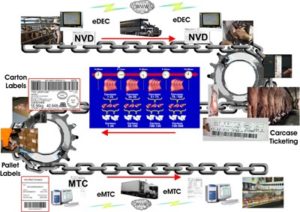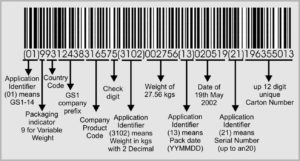Electronic systems in the Meat Indusrty
The red meat supply chain has adopted the GS1 (GS1 Australia is a not-for-profit organisation that locally administers the global multi-industry system of identification and communication for products, services, assets and locations – the GS1 System.) standards for Numbering, Bar coding and Electronic messaging for specific red meat supply chain activities such as:
- carton labelling
- carcase ticketing
- pallet labelling
- electronic messaging for National Vendor Declarations (eDEC)
- Electronic Meat Transfer Certificates (eMTC).
Many meat processing plants have commenced introducing these electronic systems. Therefore meat processing workers need not only be aware that these systems exist, but also of the responsibilities associated with their daily work.
The diagram below shows the red meat supply chain and identifies each of the activities, what the relationship is of each of the activities and their respective importance along the supply chain.
© Meat and Livestock Australia
The implementation is being coordinated by the Red Meat Supply Chain Committee. To date the committee has produced the Australian Red Meat Numbering and Bar coding guidelines for non-retail meat products, Message Implementation Guidelines, technical fact sheets, case studies, interactive CDs and a cost benefit analysis relating to project outcomes.
What is a Variable Weight Carton Label?
The Australian red meat industry Standard Variable Weight Carton Label uses Bar code symbology known as GS1-128. The GS1-128 bar code allows primary item information and secondary attribute information to be represented in the bar code. Application Identifiers (AIs) effectively act as prefixes for this information and define the meaning and structure of the embedded data.
GS1 Australia allocates a parcel of numbers to member companies. These numbers include a GS1 Company Prefix to identify the company and a range of numbers to identify products (which members themselves allocate sequentially), followed by a Check Digit which is mathematically calculated to verify that the details of the GS1 number (GTIN) are correct.
The system also allows the meat processor to represent attribute information such as batch numbers, serial numbers, expiry dates and weight in a standard format. This ensures that the attribute information encoded by one company can also be scanned and interpreted by any other company in the supply chain.
Below is an example of a carton label.

What are the operator’s responsibilities in relation to Variable Weight Carton Labels?
Operators handling carton labels would not usually be responsible for setting up and encoding the labels.
However, they will need to check that:
- all information of the label is clear and legible
- the print registration is correct and no information has been miss-printed on the label
- the bar code is at least 8mm from any edge
- no crinkling or jamming that may have damaged the bar code has occurred while printing
- labels are correctly positioned on the carton and
- no crinkling or other damage to the label that will stop the bar code being scanned or information being read has occurred
- the label is not be covered by the carton lid, strapping or any other labels or packaging
- no domestic or other manually or automatically applied stamps cover any portion of the bar code or commercial information
- samples are scanned to check that the bar codes are scannable as per company QA program.
